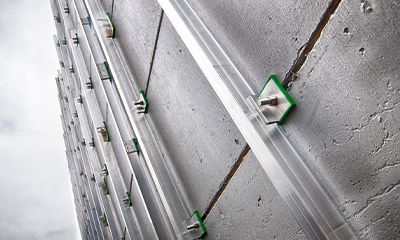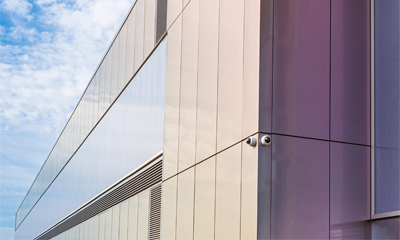Written by Hitesh Pattni (North) and Neil Kirwan (South) - Specification Managers in SFS Group Fastening Technology Ltd.
Engaging with product manufacturers helps to select the best material grades to guard against corrosion in a wide range of environments.
Guarding against the corrosion of building envelope elements and components ensures system build-ups deliver their expected long-term performance. Nobody knows products better than product manufacturers, so engaging with them to select the correct material grades can help to deliver the most sustainable solutions.
Corrosion is a definitive and visible failure of a component. It might seem obvious, or common knowledge, that certain locations/external environment, such as the coast, are more exposed and prone to corrode materials. As we'll see in this blog post, however, the changing nature of our urban environments means assessing corrosion risks should be a more widespread practice.
Performance criteria like thermal performance and fire safety are areas where 'success' can feel hard to measure. Both depend on many different components being correctly specified and installed in complex building designs that have been properly assessed for compliance. The performance that's actually delivered may never be properly tested. Only in-use monitoring of the building envelope can truly assess thermal performance, and depends on a commitment to evaluating the finished building.
Fire safety, meanwhile, can only be tested in the event of a fire - a situation that nobody wants to see. If corrosion occurs, however, it is a failure that cannot be passed off as a fault of another product or a different area of design. The corroded component was clearly the wrong component.
Project location significantly influences performance. Within the building envelope, it is critical that correct material grades are used for primary and secondary fixings. If a failure occurs, addressing it is likely to have significant practical and financial ramifications.
A specifier might be aware of location constraints and feel confident in selecting appropriate components across different projects. A robust specification, however, is one that ensures the building envelope delivers its performance for the long-term.
Planning for the future is required, which means thinking about air quality issues that have come to the fore in recent years. Government advice, published in 2018, cites poor air quality as the largest risk to public health in the UK, and links it to a number of chronic conditions and diseases. And recall how the reduction in air pollution during Covid-19 lockdowns in India gave some people in the north of the country a view of the Himalayas for the first time in their lives.
Increasing levels of air pollution in cities - and a failure to get to grips with existing air pollution levels - affects the performance and durability of building fixings. Expecting previously appropriate specifications to still be suitable for city center locations should no longer be the default approach.
Specifiers can engage with manufacturers at the start of projects to establish the appropriate grades of fixings and other components, depending on the location of the building envelope.
Any such specification is only robust, however, if the components go on to be used on site.
Product substitutions, especially where the replacement component is not to specification, must not be allowed. They void warranties and, more seriously, can lead to a failure of the façade.
It's essential that contractors and installers work with the project team to understand the importance of maintaining the specification as produced.
If you'd like to learn more about corrosion, warranties and supply chain challenges specifically, click here.
For more information on robust, sustainable building envelope specifications, and the benefits of engaging with product manufacturers, take a look at our series of technical papers in 'SFS Talks' here.
What are the effects of corrosion on building materials?
Corrosion affects building materials in different ways. Ultimately corrosion will negatively impact the technical performance of a material to the point that it fails to perform its required function.
If so, how can you do corrosion control?
The impacts of corrosion can be controlled on a construction project by correctly specifying materials that's rate of corrosion out lasts the desired working life of the building and by ensuring materials do not come into contact with environmental factors through the building design.
What are other contributing factors of corrosion?
Other factors include where a buildings environment is modified through a change of use not originally intended or where scheduled preventative maintenance is not carried out.
What are appropriate corrosion protection technologies?
For many materials corrosion cannot be stopped completely, only the rate of corrosion is controlled. Manufacturers design products for an intended use and as such will have a prescribed performance, working with manufacturers will help specifiers to select the right product for the application.
Manufacturer Engagement & Corrosion Risks
How can early manufacturer engagement aid understanding about corrosion risks in building envelopes?
Engaging with product manufacturers helps to select the best material grades to guard against corrosion in a wide range of environments.
Guarding against the corrosion of building envelope elements and components ensures system build-ups deliver their expected long-term performance. Nobody knows products better than product manufacturers, so engaging with them to select the correct material grades can help to deliver the most sustainable solutions.
Corrosion is a definitive and visible failure of a component. It might seem obvious, or common knowledge, that certain locations/external environment, such as the coast, are more exposed and prone to corrode materials. As we'll see in this blog post, however, the changing nature of our urban environments means assessing corrosion risks should be a more widespread practice.
What does 'good' look like in terms of corrosion?
Performance criteria like thermal performance and fire safety are areas where 'success' can feel hard to measure. Both depend on many different components being correctly specified and installed in complex building designs that have been properly assessed for compliance. The performance that's actually delivered may never be properly tested. Only in-use monitoring of the building envelope can truly assess thermal performance, and depends on a commitment to evaluating the finished building.
Fire safety, meanwhile, can only be tested in the event of a fire - a situation that nobody wants to see. If corrosion occurs, however, it is a failure that cannot be passed off as a fault of another product or a different area of design. The corroded component was clearly the wrong component.
Project location significantly influences performance. Within the building envelope, it is critical that correct material grades are used for primary and secondary fixings. If a failure occurs, addressing it is likely to have significant practical and financial ramifications.
Corrosion specifications for long-term thinking
A specifier might be aware of location constraints and feel confident in selecting appropriate components across different projects. A robust specification, however, is one that ensures the building envelope delivers its performance for the long-term.
Planning for the future is required, which means thinking about air quality issues that have come to the fore in recent years. Government advice, published in 2018, cites poor air quality as the largest risk to public health in the UK, and links it to a number of chronic conditions and diseases. And recall how the reduction in air pollution during Covid-19 lockdowns in India gave some people in the north of the country a view of the Himalayas for the first time in their lives.
Increasing levels of air pollution in cities - and a failure to get to grips with existing air pollution levels - affects the performance and durability of building fixings. Expecting previously appropriate specifications to still be suitable for city center locations should no longer be the default approach.
Specifiers can engage with manufacturers at the start of projects to establish the appropriate grades of fixings and other components, depending on the location of the building envelope.
Any such specification is only robust, however, if the components go on to be used on site.
Product substitutions, especially where the replacement component is not to specification, must not be allowed. They void warranties and, more seriously, can lead to a failure of the façade.
It's essential that contractors and installers work with the project team to understand the importance of maintaining the specification as produced.
Want to find out more?
If you'd like to learn more about corrosion, warranties and supply chain challenges specifically, click here.
For more information on robust, sustainable building envelope specifications, and the benefits of engaging with product manufacturers, take a look at our series of technical papers in 'SFS Talks' here.
FAQs
What are the effects of corrosion on building materials?
Corrosion affects building materials in different ways. Ultimately corrosion will negatively impact the technical performance of a material to the point that it fails to perform its required function.
If so, how can you do corrosion control?
The impacts of corrosion can be controlled on a construction project by correctly specifying materials that's rate of corrosion out lasts the desired working life of the building and by ensuring materials do not come into contact with environmental factors through the building design.
What are other contributing factors of corrosion?
Other factors include where a buildings environment is modified through a change of use not originally intended or where scheduled preventative maintenance is not carried out.
What are appropriate corrosion protection technologies?
For many materials corrosion cannot be stopped completely, only the rate of corrosion is controlled. Manufacturers design products for an intended use and as such will have a prescribed performance, working with manufacturers will help specifiers to select the right product for the application.

 English (Canada)
English (Canada)
 čeština (Česká republika)
čeština (Česká republika)
 magyar (Magyarország)
magyar (Magyarország)
 Deutsch (Deutschland)
Deutsch (Deutschland)
 eesti (Eesti)
eesti (Eesti)
 español (España)
español (España)
 português (Portugal)
português (Portugal)
 English
English
 suomi (Suomi)
suomi (Suomi)
 français (France)
français (France)
 italiano (Italia)
italiano (Italia)
 Nederlands (Nederland)
Nederlands (Nederland)
 norsk, bokmål (Norge)
norsk, bokmål (Norge)
 polski (Polska)
polski (Polska)
 svenska (Sverige)
svenska (Sverige)
 Türkçe (Türkiye)
Türkçe (Türkiye)




